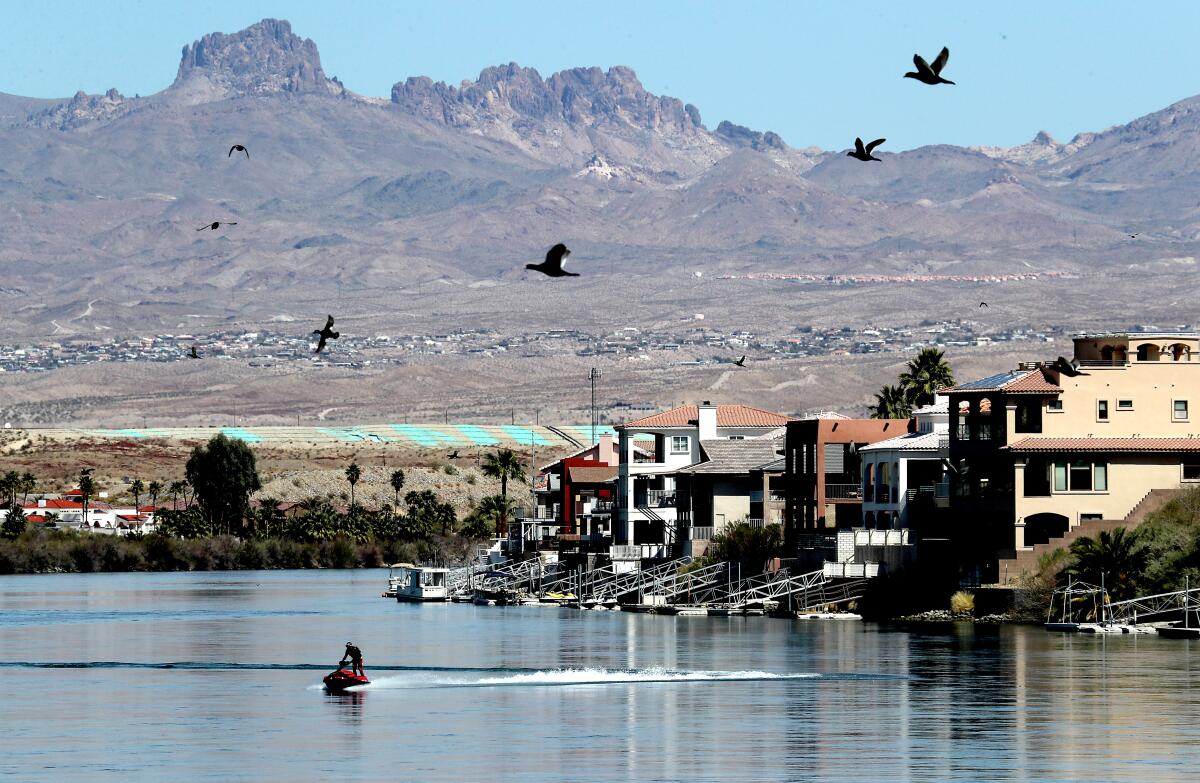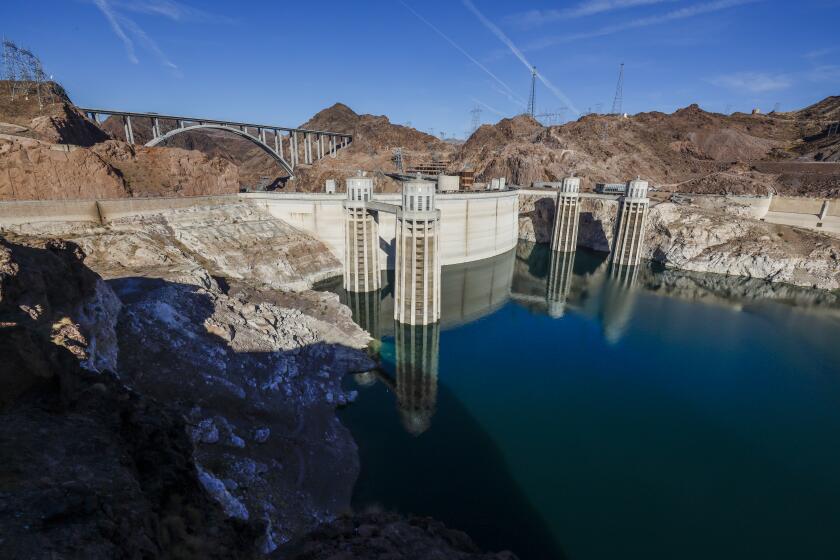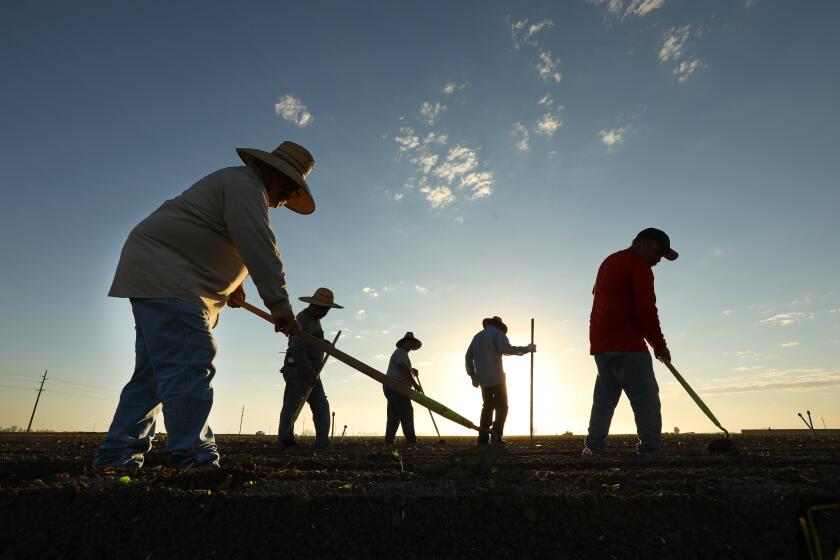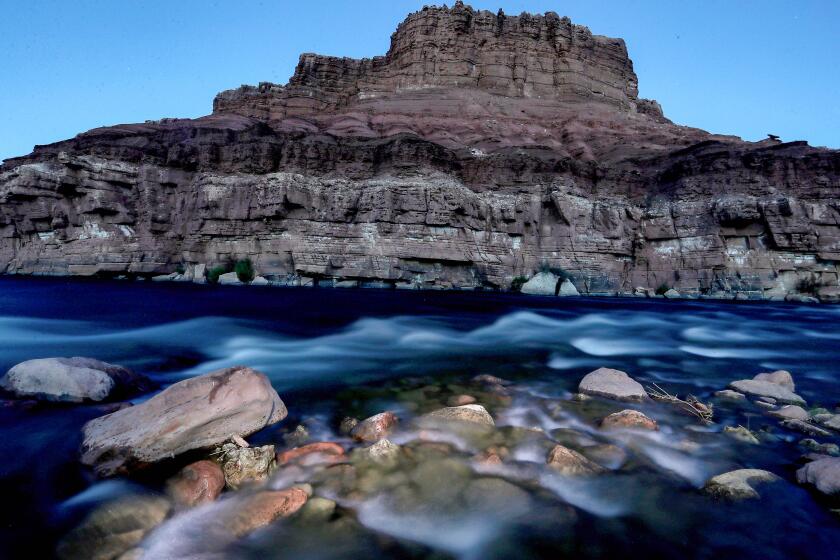As Colorado River shrinks, water evaporation becomes critical to California’s future supplies

- Share via
Much of the Colorado River’s water is diverted from reservoirs and transported in canals to the farmlands and cities of the desert Southwest. But some of the water also ends up going elsewhere — vanishing into thin air.
Water lost to evaporation has become a central point of contention in the disagreement between California and six other states over how to divide reductions in water use.
A proposal submitted by Arizona, Colorado, Nevada, New Mexico, Utah and Wyoming calls for relying heavily on counting evaporation and other water losses from reservoirs and along the river in the Lower Basin — the portion of the watershed that begins near the Grand Canyon and stretches to northern Mexico.
Counting those losses would mean immediate reductions of more than 1.5 million acre-feet across the region. It would also translate into especially large water cutbacks for California, which uses the single largest share of the river.
Under the proposal by the six states, Southern California water agencies would be required to absorb the largest share of the cuts, including a potential reduction of more than 18% for the evaporation losses alone, which could rise to 32% if reservoirs hit critically low levels.
The proposal also calls for major reductions in Arizona and Nevada. But the portions of those cuts based on accounting for evaporation would be smaller: about 13% for Arizona and 6% for southern Nevada.
How to divide Colorado River cuts: A breakdown of how California’s proposed water reductions compare with an offer submitted by six other states
California’s water managers argue that suddenly including evaporation in the math would amount to a drastic rewriting of the rules that would flout the water-rights system. They have proposed a different approach that calls for more gradual reductions and wouldn’t involve evaporation losses.
“California’s focus has been, what can we do in the interim that’s pragmatic, practical, doable, that’s not going to make big, lasting changes,” said Wade Crowfoot, California’s natural resources secretary. He said changes that would compromise existing water rights would be “a bridge too far in the near term.”
The Colorado River supplies water to farming areas, cities and tribal nations from the Rocky Mountains to northern Mexico. Chronic overuse combined with 23 years of severe drought and the effects of climate change have pushed the river’s two largest reservoirs, Lake Mead and Lake Powell, to their lowest levels since they were filled.
The growing risk of a collapse in the water supply has prompted federal officials to demand that the states come up with approaches for preventing reservoirs from bottoming out.
The states’ proposal calls evaporation and other water losses “infrastructure protection volumes,” or IPV, and says these amounts should be immediately applied as reductions. In addition to cuts in California, Arizona and Nevada, the proposal includes some potential reductions by Mexico, which would need to be negotiated.
Water managers in Arizona and Nevada say counting evaporation would be a fair way to adapt and help close the gaping water deficit.
“It is the most equitable way to match the physical reality,” said Tom Buschatzke, director of the Arizona Department of Water Resources. “It’s a simple thing to calculate and implement.”
One California water manager says Colorado River reservoirs aren’t likely to refill. Scientists agree that the region needs to plan for a drier future.
The idea behind the proposal is that each water agency would be assigned an amount of estimated losses based on where the water is diverted and how much evaporated, seeped out or was taken up by vegetation along the way.
“Everyone is used to historically getting their full entitlement and the losses being assessed against the system, not against their entitlement,” Buschatzke said. “So every single water user is going to have less water to use than they have had historically.”
The federal Bureau of Reclamation is considering the proposals as part of a review and looking at options for making cuts as officials decide how to revise the rules for dealing with shortages. They plan to finalize a decision this summer.
The proposal from the six states draws on suggestions by Las Vegas’ water managers at the Southern Nevada Water Authority, who called for “equitable sharing of evaporation and system losses” in a December proposal to the federal government.
The Nevada water agency presented an analysis last year estimating the water losses between Lees Ferry, located just downstream from Glen Canyon Dam, and the U.S.-Mexico border, including losses from the reservoirs Lake Mead, Lake Mohave and Lake Havasu, as well as along the river.
The analysis divided the losses among the three states and Mexico, and also calculated individual “assessments” for agencies that supply farms and cities, as well as for other entities, such as the Colorado River Indian Tribes, whose water flows to farmland beside the river.
As climate change and overuse threaten the Colorado River, Native American tribes seek a larger role in the river’s stewardship.
Using this approach, the biggest reductions would fall to California’s Imperial Irrigation District, which uses the single largest share of the river to supply farms in the Imperial Valley that produce crops including hay for cattle, wheat and vegetables such as lettuce and onions.
The proposal has farmers concerned.
“Evaporation has never been part of the equation,” said John Hawk, a farmer and Imperial County supervisor. “That’s rewriting the rules. That’s what they want to do. They want to hammer away at priority users.”
Nevada’s analysis last year listed a potential reduction of more than 500,000 acre-feet for the Imperial Irrigation District, which is about 20% of its annual water use.
The Imperial Irrigation District holds some of the most senior water rights on the river, dating to 1901. Under the existing water-rights system, that makes the district among the last in line to be required to take cuts in a shortage.
As the federal government pushes states to reduce usage of dwindling Colorado River water, Imperial Valley farmers fear a “worst-case” scenario.
Farmers and landowners, as well as Southern California water officials, say they’re concerned about attempts to undermine the legal system governing water use that has developed over the last century, called the Law of the River.
“We all live by rules and agreements. This new idea, evaporation on the river, would negatively impact Imperial,” Hawk said, adding that such large reductions would bring an economic blow on both sides of the California-Mexico border, affecting communities that depend on agriculture.
Factoring in the water lost to evaporation would also affect the Metropolitan Water District of Southern California, which supplies 26 member agencies that serve 19 million people. MWD officials say preliminary estimates based on the six-state proposal point to a potential reduction of at least 15% to 20% for evaporation losses, plus additional significant cuts.
“It would affect us disproportionately,” said Bill Hasencamp, MWD’s manager of Colorado River resources. “This isn’t a be-all, end-all proposal. And frankly, Reclamation is going to have a hard time modeling this proposal.”
Representatives of the seven states plan to hold more negotiations in private, and many have said that despite the disagreements, they will continue trying to reach a consensus.
J.B. Hamby, the chair of California’s Colorado River Board, called the idea of factoring in evaporation losses “troubling and problematic,” and said it “does not harmonize with the Law of the River as we all know it.”
At the heart of tensions over water allotments from the Colorado River is a complex set of agreements and decrees known as the ‘Law of the River.’
The dispute has roots in the agreements, court decisions and rules that govern how the river is managed.
The 1922 Colorado River Compact divided water among the seven states. But the issue of evaporation has long been treated differently in the river’s Upper Basin states — Colorado, Wyoming, Utah and New Mexico.
Under a 1948 compact, the Upper Basin states defined “consumptive use” of water based on the “man-made depletions of the virgin flow” of the river at Lees Ferry, the dividing line between the upper and lower parts of the basin.
For those states, water losses to evaporation have long been counted against their apportionments, said Eric Kuhn, an author and former Colorado water manager.
But in the three Lower Basin states, Kuhn said, those losses were never considered as part of the water delivery contracts. The amount of water used has been calculated as the amount diverted minus return flows to the river — which happens in farming areas such as Blythe, where water flows off farmlands and runs back into the Colorado.
That approach was supported by the U.S. Supreme Court in its landmark 1963 decision in the case Arizona vs. California and its subsequent 1964 decree, which settled a long-standing dispute between the states over Colorado River water.
Kuhn said the conflict “all goes back to the definition of consumptive use,” and he hopes the two sides can reach a compromise on the issue.
Other experts have supported the idea of taking evaporation losses into account.
“The pain has to be shared broadly,” said John Fleck, a water researcher and writer in residence at the Utton Center at the University of New Mexico’s School of Law. “This is a method for responding to the reality that climate change has fundamentally changed the nature of the river from the one we made all these deals about over the last century.”
In his proposal to the federal government, Fleck wrote that by ignoring these losses, the Supreme Court “pointed the river’s management bus toward a ditch.”
“In the years since, we were unable to grab the wheel and turn it,” Fleck wrote. “We are now in that ditch.”
Colorado River in Crisis is a series of stories, videos and podcasts in which Los Angeles Times journalists travel throughout the river’s watershed, from the headwaters in the Rocky Mountains to the river’s dry delta in Mexico.
Evaporation should have been incorporated into the allocations from the beginning, said Kathy Jacobs, director of the University of Arizona’s Center for Climate Adaptation Science and Solutions.
“It is clearly fair to count losses to evaporation in proportion to the size of the allocations as a way to achieve cuts,” Jacobs said, “but it is unfortunately not enough.”
Climate change has dramatically altered the river. In the last 23 years, as rising temperatures have intensified the drought, the river’s flow has declined about 20%.
Scientists have found that roughly half the decline in the river’s flow has been caused by higher temperatures, and that for each additional 1 degree Celsius (1.8 degrees Fahrenheit) of warming, the river’s average flow probably will decrease about 9%.
“Fundamentally, the seeds of this current situation were planted decades ago when the U.S. decided to irrigate a desert with Colorado River water,” said David Pierce, a climate scientist at Scripps Institution of Oceanography. He pointed out that about 80% of the river’s water continues going to farming.
“The system was carefully calibrated to just break even in the absence of climate change. Climate change is that last push on water availability that throws the whole system off,” he said.
Pierce said he thinks it would make sense to account for evaporation losses. He pointed out that Lake Mead has been losing about 6 feet of water per year to evaporation, although the losses decrease as the reservoir shrinks.
“The issue, of course, is whose allocation the evaporation is taken out of,” Pierce said. “I’m sure there will be many arguments about that.”















